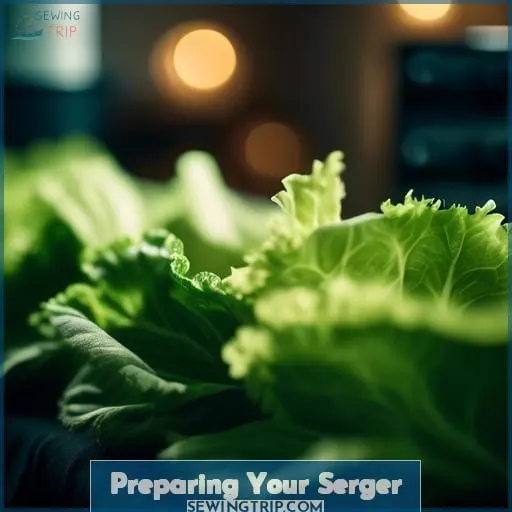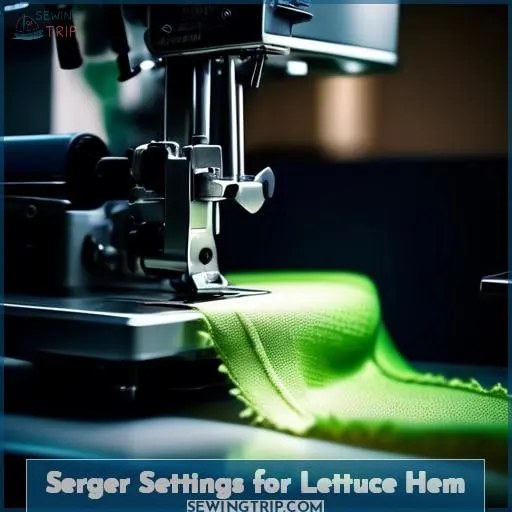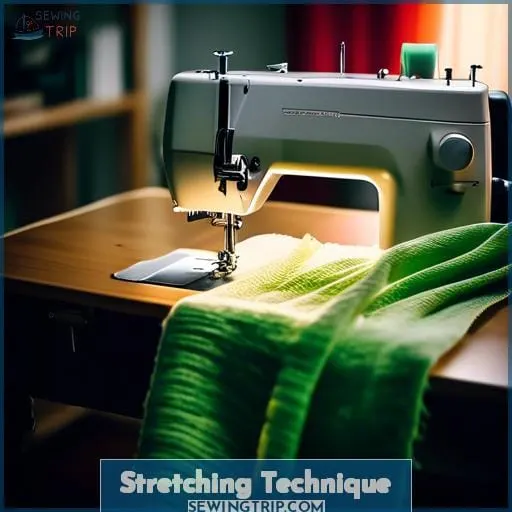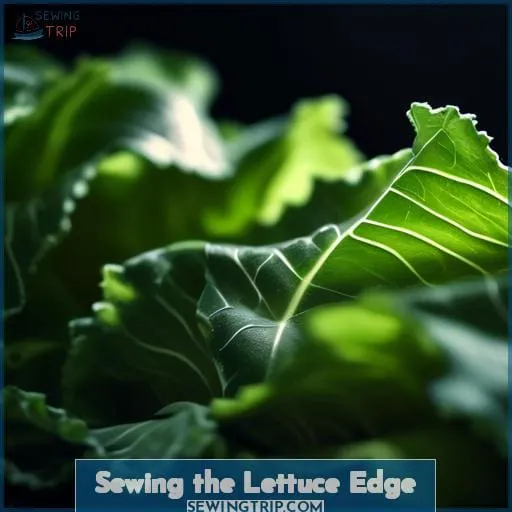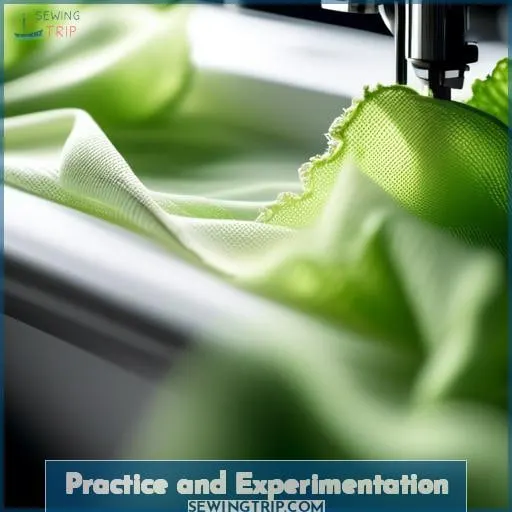This site is supported by our readers. We may earn a commission, at no cost to you, if you purchase through links.
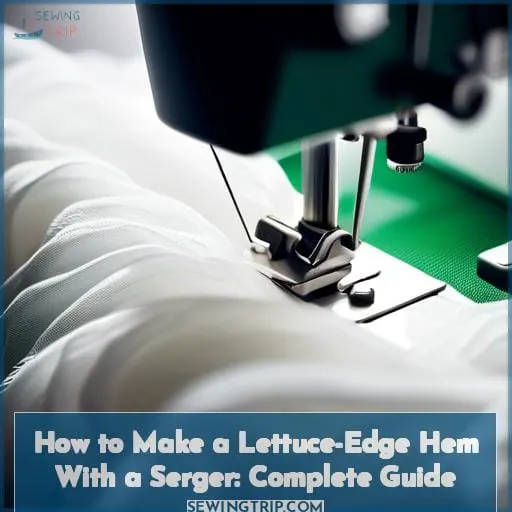 Transform your knit garments with a chic lettuce-edge hem using your serger! This guide will walk you through the process, ensuring you achieve that playful, ruffled finish that’s perfect for adding a touch of whimsy to any outfit.
Transform your knit garments with a chic lettuce-edge hem using your serger! This guide will walk you through the process, ensuring you achieve that playful, ruffled finish that’s perfect for adding a touch of whimsy to any outfit.
Whether you’re a seasoned sewer or just starting, you’ll find that mastering the lettuce-edge hem with a serger elevates your sewing projects with a professional and stylish flair.
Table Of Contents
- Key Takeaways
- How to Make Lettuce Edge Hem With Serger
- What is a Lettuce-Edge Hem?
- Preparing Your Serger
- Serger Settings for Lettuce Hem
- Stretching Technique
- Sewing the Lettuce Edge
- Troubleshooting Common Issues
- Benefits of Lettuce Edging
- Practice and Experimentation
- Finishing Touches
- Frequently Asked Questions (FAQs)
- Conclusion
Key Takeaways
- Use stretchy, lightweight knit fabrics for creating lettuce edge hems, as they allow for the necessary elasticity and ruffling effect.
- Prepare the serger by removing the stitch finger, setting the differential feed below 1, using the appropriate needle for rolled hems, and adjusting tension settings (UL to 4, LL to 8 or 9, RN to 7).
- When sewing, stretch the fabric evenly both in front of and behind the presser foot to ensure consistent ripples and waves along the hem.
- After sewing, check the wave consistency and adjust tension dials, stitch length, and width as needed to achieve the desired lettuce edge appearance.
How to Make Lettuce Edge Hem With Serger
Yes, to make a lettuce edge hem with a serger, set your serger to a rolled hem setting, decrease the differential feed to less than 1, and adjust the tension dials, then stretch the fabric as you serge.
What is a Lettuce-Edge Hem?
A lettuce-edge hem is a decorative finish that adds a playful, wavy texture to the edges of garments. It’s achieved by stretching the fabric while sewing with a tight stitch, typically on knit or bias-cut fabrics, to create the characteristic ripples.
This technique is ideal for adding a unique touch to skirts, dresses, and other knitwear, and it requires a stretchy fabric to ensure the proper effect.
When setting up your serger for a lettuce-edge hem, you’ll need to make specific adjustments. Remove the stitch finger, set the differential feed to less than 1, use only the right needle, and adjust the stitch length to the rolled hem setting.
Tension dials should be set with the upper looper at 4, the lower looper at 8 or 9, and the right needle at 7, while the left needle isn’t used.
During the sewing process, the fabric should be stretched both in front of and behind the presser foot to encourage the fabric to ripple. If issues arise, such as the fabric not rolling or stitches not covering the fabric, adjustments to the tension settings, stitch length, or fabric choice may be necessary.
Lettuce-edge hems aren’t only aesthetically pleasing but also add a flirty and feminine flair to garments. They’re versatile and can be applied to various clothing items, from casual wear to more formal attire.
Characteristics of Lettuce-Edge Hem
A lettuce-edge hem is a whimsical finish that adds a playful ripple to the edges of stretchy garments. Picture the wavy frills of a leaf of lettuce—that’s the look you’re aiming for.
It’s a cinch to create with a serger, once you’ve got the hang of it. You’ll need to tweak your serger’s settings—ditch the stitch finger, dial down the differential feed, and adjust the tension to get that perfect, undulating effect.
It’s a bit like a dance: you stretch the fabric as it feeds through, and the serger does the rest, stitching a wavy line that bounces back into a frill. It’s not rocket science, but it does require a bit of practice to nail the technique.
The result? A durable, cost-effective, and stylish finish that’s as fun to make as it is to wear. Whether you’re jazzing up a jersey tee or adding flair to a skirt, the lettuce hem is a simple way to inject a dash of creativity into your sewing projects.
Suitable Fabrics for Lettuce-Edge Hem
When you’re aiming to add a whimsical twist to your garment with a lettuce-edge hem, think stretch and flexibility.
You’ll want fabrics that can take a bit of a dance under the needle—think knit fabrics with a good amount of stretch. Too thick and your hem will throw a tantrum, refusing to curl; too stiff, and it’ll just stand there, unimpressed by your efforts.
Aim for a fabric weight that’s not too heavy, as you’ll need to stretch it while sewing to achieve that characteristic wavy charm. Remember, the fabric’s stretchiness is your dance partner here, so choose one that can keep up with the rhythm of your differential feed and rolled hem settings.
Preparing Your Serger
To prepare your serger for creating a lettuce-edge hem, you’ll need to make a few adjustments.
First, remove the stitch finger to allow for the fabric to roll more easily.
Next, set the differential feed to a lower setting than 1 to encourage the fabric to gather and create the wavy edge characteristic of a lettuce hem.
Finally, you’ll want to use only the right needle for this technique, as it’s designed to work with a narrower stitch that’s typical for rolled hems.
Removing the Stitch Finger
To remove the stitch finger on your serger, you’re diving into the heart of the machine’s settings, a small but mighty adjustment that paves the way for the charming ruffles of a lettuce edge hem.
Think of the stitch finger as the unsung hero of serger anatomy, guiding threads into precise stitches.
By disengaging this tiny part, you’re allowing the fabric to fully embrace the stretch needed for that signature wavy look. It’s a simple step, but it’s like flipping a switch from the everyday to the extraordinary in your sewing escapades.
Adjusting the Differential Feed
After removing the stitch finger from your serger, it’s time to tweak the differential feed.
This nifty feature is like a secret weapon for preventing puckers in lightweight fabrics or stopping stretchy materials from waving goodbye to their shape. By dialing down the differential feed to below 1, you’re setting the stage for a ruffle that’s as playful as a puppy’s wag.
Think of it as the choreographer for your fabric, ensuring every thread falls into a harmonious dance of gathers or stretches. So, grab a practice fabric, maybe an old onesie you’re refashioning, and let the maxi lock thread pirouette into a rolled hem stitch or a narrow hem stitch that’s sure to make your garment twirl with joy.
Setting Needles for Lettuce Hem
Creating a lettuce-edge hem with a serger involves a blend of technical settings and a bit of artistry, especially when it comes to needle positioning.
After adjusting your serger’s differential feed to stretch the fabric just right, it’s time to focus on the needles, crucial for achieving that iconic wavy edge. For a lettuce hem, you’ll only need the right needle, simplifying the process but demanding precision.
Ensure the right needle tension is set correctly, typically around 7, to balance the loopy, ruffled effect without compromising stitch integrity. Removing the left needle streamlines the stitch pattern, directing the focus to the fabric’s edge where the magic happens.
Choose the right needle type and size to match your fabric, usually a size 11 or 14 for most knits, to prevent skipped stitches or fabric damage. This setup is perfect for adding a playful touch to baby tees or any stretchy garment, turning simple edges into eye-catching details.
Serger Settings for Lettuce Hem
To achieve the perfect lettuce-edge hem with your serger, you’ll need to fine-tune your machine’s settings.
Start by setting your stitch length to R for a rolled hem and adjust your stitch width to the same if your machine has this option.
Then, dial in your tension settings: set the upper looper (UL) to 4, the lower looper (LL) to 8 or 9, and the right needle (RN) to 7, ensuring the left needle is removed as it’s not used in this process.
Stitch Length and Width Adjustments
Alright, let’s dive into the nitty-gritty of serger settings for that whimsical lettuce-edge hem. It’s like tuning a guitar; get the settings just right, and you’ll be sewing sweet music with fabric.
- Stitch variety is your creative palette. Dial in the R for a tight, rolled hem that sings on the edge of your fabric.
- Tension impact is huge. Think of it as the tightrope balance between puckered and perfect. UL at 4, LL at 8 or 9, and RN at 7 should do the trick.
- Fabric compatibility is key. If your fabric’s throwing a tantrum and not rolling, it’s time to troubleshoot. Maybe it’s too stiff or the tension’s off.
- Adjustment optimization is your path to serger mastery. Stretch that fabric like it’s yoga for cloth, and watch the magic happen as you sew.
Tension Dial Settings
After dialing in your stitch length and width, you’ll need to tweak your tension settings to perfect that wavy charm. Think of tension as the spice of sewing—just the right amount and you’ve nailed the recipe.
| Tension Part | Setting |
|---|---|
| Upper Looper | 4 |
| Lower Looper | 7-9 |
| Right Needle | 7 |
| Left Needle | N/A |
Stretching Technique
Creating a lettuce-edge hem with a serger involves a specific stretching technique that’s crucial for achieving the desired wavy or rippled effect.
This technique requires you to stretch the fabric both in front of and behind the presser foot as it feeds through the machine. Ensuring an even stretch throughout the sewing process is key to producing a consistent and attractive lettuce edge.
This method leverages the fabric’s elasticity, combined with adjusted serger settings, to create a decorative finish that adds a unique flair to garments.
Stretching Fabric in Front and Behind the Foot
To achieve the whimsical waves of a lettuce-edge hem, you’ll need to master the stretching technique.
- Stretch the fabric in front of the foot like you’re playing tug-of-war with a playful puppy, ensuring it’s taut but not overstrained.
- Pull the fabric behind the foot as if you’re smoothing the train of a gown down a grand staircase.
- Maintain an even stretch throughout, akin to balancing a tightrope walker’s pole, to avoid a wonky hemline.
Achieving Even Stretch Throughout
Creating a lettuce-edge hem with a serger is a delightful way to add a whimsical touch to your sewing projects. This technique, perfect for stretchy knit fabrics, results in a charmingly ruffled edge reminiscent of lettuce leaves.
To achieve this effect, it’s crucial to master the art of stretching your fabric correctly as it feeds through the serger.
Firstly, ensure your serger is set up for a rolled hem, which typically involves removing the left needle, adjusting the differential feed to a setting lower than 1, and setting the stitch length to R for a rolled hem.
The right needle tension should be around 7, with the upper looper at 4 and the lower looper between 8 and 9.
The key to a beautiful lettuce edge lies in the stretch amount and fabric tension. As you sew, gently but firmly stretch the fabric both in front of and behind the presser foot. This action encourages the fabric to curl and wave, creating the signature lettuce-edge look.
It’s a balancing act; too little stretch and your hem will be flat, too much and it might become distorted. Aim for stretch consistency, ensuring an even pull throughout the sewing process to achieve a uniform ruffle.
In summary, achieving an even stretch throughout is crucial for a successful lettuce-edge hem. By carefully managing the stretch amount and fabric tension, and adjusting your serger settings accordingly, you’ll be able to add a playful and professional-looking finish to your garments.
Sewing the Lettuce Edge
To start creating a lettuce-edge hem with your serger, begin with a chain off the fabric edge.
Then, carefully feed the fabric under the presser foot to initiate the rolled hem process.
Starting With a Chain
Creating a lettuce-edge hem with a serger adds a playful and decorative touch to knit garments, transforming ordinary edges into eye-catching features.
- Start your serging journey by initiating a starting chain. This acts as your runway, guiding the fabric smoothly under the presser foot.
- Position the knit edge just right under the foot, ready to embrace the transformation into a ruffled masterpiece.
- Embrace the fabric stretch, both in front and behind the presser foot, as if you’re coaxing the fabric to perform its best wave.
- Tension adjustments are your secret sauce. They fine-tune the seam finish, ensuring every stitch contributes to the perfect ruffle.
Feeding the Fabric for Rolled Hem
After you’ve started with a chain, it’s time to dive into the main event: feeding your fabric for that dreamy rolled hem.
Adjust your serger tension and check fabric compatibility to avoid any hiccups.
With a keen eye on differential adjustment, employ your stretching technique to ensure the fabric flows smoothly.
Troubleshooting Common Issues
If you’re encountering issues while trying to create a lettuce-edge hem with your serger, there are a couple of common problems to look out for.
If your fabric isn’t rolling, it might be too stiff, or the tension on your lower looper or needle may be too loose; ensure your fabric is stretchy enough for this technique.
On the other hand, if your stitches aren’t covering the fabric adequately, consider shortening the stitch length, using a thicker thread, or adjusting the tension.
Fabric Doesn’t Roll
If your lettuce-edge hem isn’t rolling, it might be due to fabric stiffness, so consider pre-washing to soften it.
Tension adjustment is also key; ensure the lower looper or needle tension is tight enough.
If these steps don’t help, the fabric may not be compatible with a lettuce-edge hem.
Stitches Don’t Cover Fabric
If your stitches aren’t covering the fabric while attempting a lettuce-edge hem with your serger, don’t fret—it’s a common hiccup.
Consider the sewing speed; a steady pace allows for consistent stitch formation. Thread thickness matters too; a thicker thread can offer better coverage. Ensure your needle is sharp enough to pierce the fabric without snagging. Fabric type is crucial; opt for stretchy knits for that perfect ruffle.
Lastly, tension balance is key—adjust until the stitches sit pretty on the edge.
If you’re still in a pickle, remember practice makes perfect, and each serger has its quirks.
Benefits of Lettuce Edging
Lettuce edging adds a unique touch to your garments, making them stand out with a playful flair.
It’s versatile, allowing you to apply this technique to skirts, sleeves, and more, enhancing the overall look of your creations.
Adding Flair to Garments
Creating a lettuce-edge hem with a serger not only adds a whimsical touch to your knit garments but also injects a dose of creative flair into your sewing projects.
This decorative finish, characterized by its ruffled detailing and wavy effects, transforms ordinary pieces into eye-catching statements. Whether you’re jazzing up skirts, bloomers, or sleeves, the lettuce edge is your go-to for adding that extra oomph.
It’s a testament to the magic that happens when technique meets imagination, turning the simple act of hemming into an opportunity for artistic expression. So, stretch that fabric, let your serger dance along the edge, and watch as the ordinary transforms into the extraordinary.
Versatility Across Garment Types
Continuing from adding pizzazz to your creations, the lettuce-edge hem brings versatility to your sewing projects.
- Transforms children’s clothing with playful ruffles.
- Adds a splash of style to swimwear edges.
- Adapts to different stretch fabrics for a custom fit.
- Introduces decorative details that make your pieces pop.
Embrace the wave of creativity this technique offers!
Practice and Experimentation
To achieve a lettuce-edge hem with a serger, it’s essential to practice on scraps of fabric to get the settings right and to become comfortable with the stretching technique required. Experimentation is key, as different fabrics and sergers may require slight adjustments to the standard settings for optimal results.
When practicing, you’ll need to stretch the fabric both in front of and behind the presser foot to encourage the fabric to roll slightly, which is characteristic of the lettuce edge. The differential feed should be set to a lower number to help with the stretching effect, and the tension dials adjusted accordingly—usually with a tighter lower looper tension to create the wavy edge.
Importance of Practice on Scraps
Before diving into the main event, it’s crucial to get your feet wet with some practice runs.
You wouldn’t want your first attempt at a lettuce-edge hem to be a flop, right? So, grab those scraps and start stretching and stitching away. It’s like flexing your sewing muscles – the more you practice, the stronger your technique will become.
And when it comes to tension, it’s all about finding that sweet spot. Too loose and your fabric won’t roll, too tight and you might hear the dreaded snap of a thread. So, keep at it, and soon you’ll be creating waves in the sewing world with your perfect lettuce-edge hems.
Encouragement to Experiment
After honing your skills on scraps, it’s time to dive into the fun part: experimentation.
Think of your serger as a paintbrush and fabrics as your canvas. Mix and match, play with tension, and explore different materials.
This journey of creativity will lead you to unique finishes that add a special design flair to your creations.
So, let your imagination run wild and enjoy the adventure of fabric exploration!
Finishing Touches
Once you’ve sewn your lettuce-edge hem, it’s time to fine-tune the look.
Check the wave’s consistency and make any necessary tension adjustments for the perfect finish.
Adjusting for Desired Look
As you wrap up your lettuce-edge hem, remember, it’s all about fine-tuning. Play with your tension dials and don’t shy away from adjusting stitch length and width.
Think of fabric stretching not as a chore, but as your secret sauce to that perfect ripple.
So, dive in, experiment, and let your creativity sing!
Final Checks and Adjustments
Once you’ve got the hang of it, your lettuce-edge hem will look like it danced right off the runway.
But before you take a bow, double-check those tension settings. A wonky overlock stitch can turn chic to shabby in a stitch.
If the fabric’s not playing nice, troubleshoot with a quick tension tweak. Remember, the right fabric compatibility is your ticket to creative applications without the hiccups.
Frequently Asked Questions (FAQs)
Can I create a lettuce edge on non-stretch fabrics?
Creating a lettuce edge on non-stretch fabrics is like trying to teach a cat to swim; it’s not going to end well.
This technique thrives on stretchy materials that can curl and wave, much like a leaf of lettuce.
Stick to knits for that perfect ruffle!
How do I maintain consistent ruffles?
To keep your lettuce edge hem’s ruffles consistent, think of Goldilocks—not too tight, not too loose, just right.
Stretch the fabric evenly as it feeds through the serger, adjusting the tension dials (UL: 4, LL: 8 or 9, RN: 7) and the differential feed to below 1 to achieve the perfect wave.
What are alternatives to a serger for lettuce hems?
You can create a lettuce hem without a serger by using a zigzag stitch on a regular sewing machine.
Keep practicing; you’ll soon be ruffling like a pro!
Can I use regular thread for a lettuce hem?
Just as a magician pulls a rabbit out of a hat, you can conjure up a lettuce hem with regular thread—no special tricks required!
It’s all about the stretch and technique, not the thread type.
How do I fix a wavy lettuce hem that’s too flat?
To fix a too-flat wavy lettuce hem, increase the differential feed and tension on your serger.
Stretch the fabric more as it feeds through.
Experiment with settings and fabric stretch until you achieve the perfect ruffle.
Conclusion
Practice makes perfect, and with the techniques you’ve learned for creating a lettuce-edge hem with a serger, you’re well on your way to adding a professional and playful finish to your knit garments.
Remember to choose the right fabric, adjust your serger settings carefully, and stretch the fabric consistently as you sew.
With a bit of experimentation and a few trial runs on scrap fabric, you’ll soon be able to produce that charming ruffled effect with ease.
So go ahead, give your projects that extra flair, and watch how a simple lettuce-edge hem can transform your creations.


